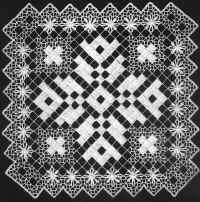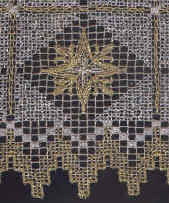|  Filet-Guipure
Lace is a kind of needlework included netting and stitching
decorating seams and figures with the help of a needle.
It is one of the earliest types of lace. The other terms
of Filet-Guipure Lace may be Darned Netting, Darned
Lace or Spider Work. A shuttle, a core, a wooden
rectangular embroidery frame and an embroidery needle are used
for Filet-Guipure Lace manufacturing. The genesis of netting
was in Neolithic (VI-III century B.C.). Most of primitive men
knew a prosaic fishing-net, mesh bags and similar household
goods. The filet (from French filet means
grid), i.e. embroidery on a netting, was known in the different
countries already in a deep antiquity, and it is difficult to
define a native land of this work. The ancient peoples living
in woods engaging by a hunt were able to entwine a network from
strings, and the inhabitants of the seaside countries made fishing
networks not worse than we do. Initially primitive filet works
was gradually improved. In due course in the various countries
began to occur graceful filet works. In Persia there are ancient
things of silk filet with gold and silver embroidery. There
are plenty of emarginate filet among ancient works in Italy. Filet-Guipure
Lace is a kind of needlework included netting and stitching
decorating seams and figures with the help of a needle.
It is one of the earliest types of lace. The other terms
of Filet-Guipure Lace may be Darned Netting, Darned
Lace or Spider Work. A shuttle, a core, a wooden
rectangular embroidery frame and an embroidery needle are used
for Filet-Guipure Lace manufacturing. The genesis of netting
was in Neolithic (VI-III century B.C.). Most of primitive men
knew a prosaic fishing-net, mesh bags and similar household
goods. The filet (from French filet means
grid), i.e. embroidery on a netting, was known in the different
countries already in a deep antiquity, and it is difficult to
define a native land of this work. The ancient peoples living
in woods engaging by a hunt were able to entwine a network from
strings, and the inhabitants of the seaside countries made fishing
networks not worse than we do. Initially primitive filet works
was gradually improved. In due course in the various countries
began to occur graceful filet works. In Persia there are ancient
things of silk filet with gold and silver embroidery. There
are plenty of emarginate filet among ancient works in Italy.

 Guipure
(from French guipure) is a kind of lace with embossed pattern.
In contradistinction to simple filet, Filet-Guipure Lace fills
almost whole netting space with a pattern. And more various
stitches are used and create an openwork lace (i.e. impression
of more thin, transparent, seen through embroidery). It is a
lot of ancient works in filet-guipure technique was kept in
France and Germany. A heyday of filet lace comes about the epoch
of Revival (XIV-XVI centuries). In the beginning of XX century
Filet-Guipure Lace was also very fashionable and was made aplenty.
A lot of insertion laces for covers, cloths, napkins and curtains Guipure
(from French guipure) is a kind of lace with embossed pattern.
In contradistinction to simple filet, Filet-Guipure Lace fills
almost whole netting space with a pattern. And more various
stitches are used and create an openwork lace (i.e. impression
of more thin, transparent, seen through embroidery). It is a
lot of ancient works in filet-guipure technique was kept in
France and Germany. A heyday of filet lace comes about the epoch
of Revival (XIV-XVI centuries). In the beginning of XX century
Filet-Guipure Lace was also very fashionable and was made aplenty.
A lot of insertion laces for covers, cloths, napkins and curtains
 were made.
were made. 
Filet-Guipure
Lace is a stitchcraft, traditional for Volga Region in Russia.
N.Tazova told about uprise of Filet-Guipure
in Russia: For the first time in Russia Filet-Guipure Lace
has appeared under Moscow at the end of the XVII century. This
history is concerned with Peter the First
At one time there
was a nunnery in the village Khotkovo under Moscow. The nuns
had some land, did small-scale housekeeping, but bent the knee
more and made bows. Once king Peter has arrived there, he has
had a look at their life, and has become angry: Why are you
dally and eat bread for nothing? Stop it! Since today you will
be worked! And he has written for two mistresses of needlework
from Holland, which began to train the nuns to make Filet-Guipure
Lace. And from this nunnery it has expanded all Russia round.
This needlework has especially circulated at our place in Volga
Region. Maybe because networks for fishing was netted in villages
here lately. Due to the vigorous activity of the National
Master N.Tazova Filet-Guipure Lace not only was kept in Volga
Region, but also has got distinguishing features of the Samara
Lace School, and consequently can be quite naturally named Samara
Guipure. 
|